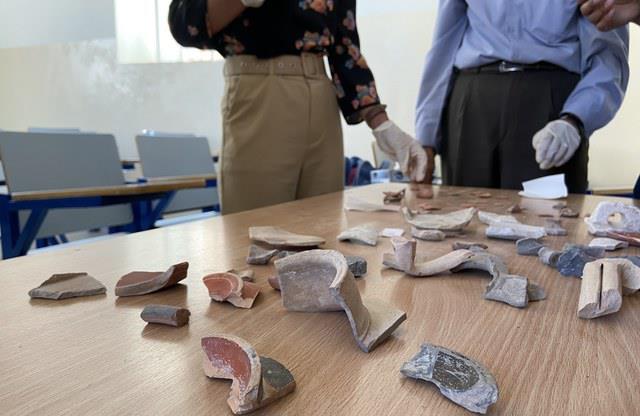
On Importance Of Pottery Analysis In Archaeology
AMMAN - Pottery reading and collecting is essential in understanding history of Southern Levant. The analysis of ancient pottery begins with an understanding of the basic vessel part as most excavated pottery is found in fragments, not intact. Syro-Palestinian archaeologists call these broken pieces "potsherds" or merely "sherds".
Most recovered sherds are body sherds (bods) which have few distinguishable characteristics since they are pieces from the side walls of the vessel which are not attached to a ring base, or handle. Bits of bases, chipped rims and broken handles are called "diagnostic" sherds since the archaeologist can use these pieces more easily to determine what the original whole form looked like than body sherds.
Body sherds can also be "diagnostic" if they have a special surface treatment, said a Norwegian researcher Bjornal Storfjell, adding that while bods may not be as useful for establishing periodisation and are seldom saved for this purpose, they may be saved by the ceramic technologist or other specialists for reasons other than to establish periodisation.
"The publication of pottery may involve either photographs or line drawings. Photographs, particularly colour photographs, provide an excellent sense of the surface treatment. They can accurately illustrate the nature of clay. However, due to expense, photographs are published sparingly and very seldom are they published in colour," Storfjell said, adding that drawings are used most often.
The art of drawing pottery has become somewhat standardised and a basic pottery drawing includes the whole or reconstructed vessel, detailed drawings of certain cross-sections (lip, handle, base, etc.), and a scale, he elaborated.
"Pottery is drawn in cross-section and exhibits several details: the overall shape of the vessel; the thickness of the vessel wall; and the shape of the parts of the vessel; the vessel is drawn as if cut in half down the middle. The left side shows the exterior of the vessel [along with any exterior surface treatment] and the right side shows the interior of the vessel also, along with any interior surface treatment," Storfjell.
Painting, slip, and glaze are indicated by grey tones. If the surface treatment has been reconstructed, the reconstructed portion may be represented by a lighter grey than the actual surface treatment.
"The right edge of the drawing is a cross-section cutting through the lip, rim and neck [if any], handle [if present], body wall, and base," Storfjell, explained, noting that if the vessel was found whole, all the exterior lines of the drawing will be solid.
Archaeologists, ceramicists, ethno-archaeologists-specialists of every stripe use a multitude of terms, some common and some technical, to describe and characterise ancient pottery. There are terms to describe every detail of every part of every aspect of the pottery vessel-form, shape, material, manufacturing - each with its own set of categories and traditions. Unfortunately, since the terminological tradition has grown along with the archaeological discipline itself this host of terms is not always used consistently or accurately, Storfjell highlighted.
Different specialists have different primary concerns, and hence, different naming schema. "Ethno-archaeologists may be more interested in the ancient manufacture or use [function] of a vessel as a window on how life was lived. Staff archaeologists who read pottery in the field may be more interested in typology based on shape [form] as a way of determining relative chronology," Storfjell underlined, adding that many are interested in aspects of both function and form. These various interests have resulted in a hybrid vocabulary which blends functional names (cup, bowl, etc.), sizes (small, medium large, etc.), and shapes (carinated, everted.), he said.
Such terminology is useful to a degree and has the inertia that comes with tradition however it is already proving to be frustratingly imprecise as specialists compare site reports, and will present increasing problems in the future-especially as the field of pottery analysis becomes more computer oriented. Databases and comparative diagnostic programmes will demand more specific terminology," Storfjell underscored.

Legal Disclaimer:
MENAFN provides the
information “as is” without warranty of any kind. We do not accept
any responsibility or liability for the accuracy, content, images,
videos, licenses, completeness, legality, or reliability of the information
contained in this article. If you have any complaints or copyright
issues related to this article, kindly contact the provider above.


















Comments
No comment